engine CADILLAC CATERA 1998 1.G Owners Manual
[x] Cancel search | Manufacturer: CADILLAC, Model Year: 1998, Model line: CATERA, Model: CADILLAC CATERA 1998 1.GPages: 346, PDF Size: 19.13 MB
Page 271 of 346
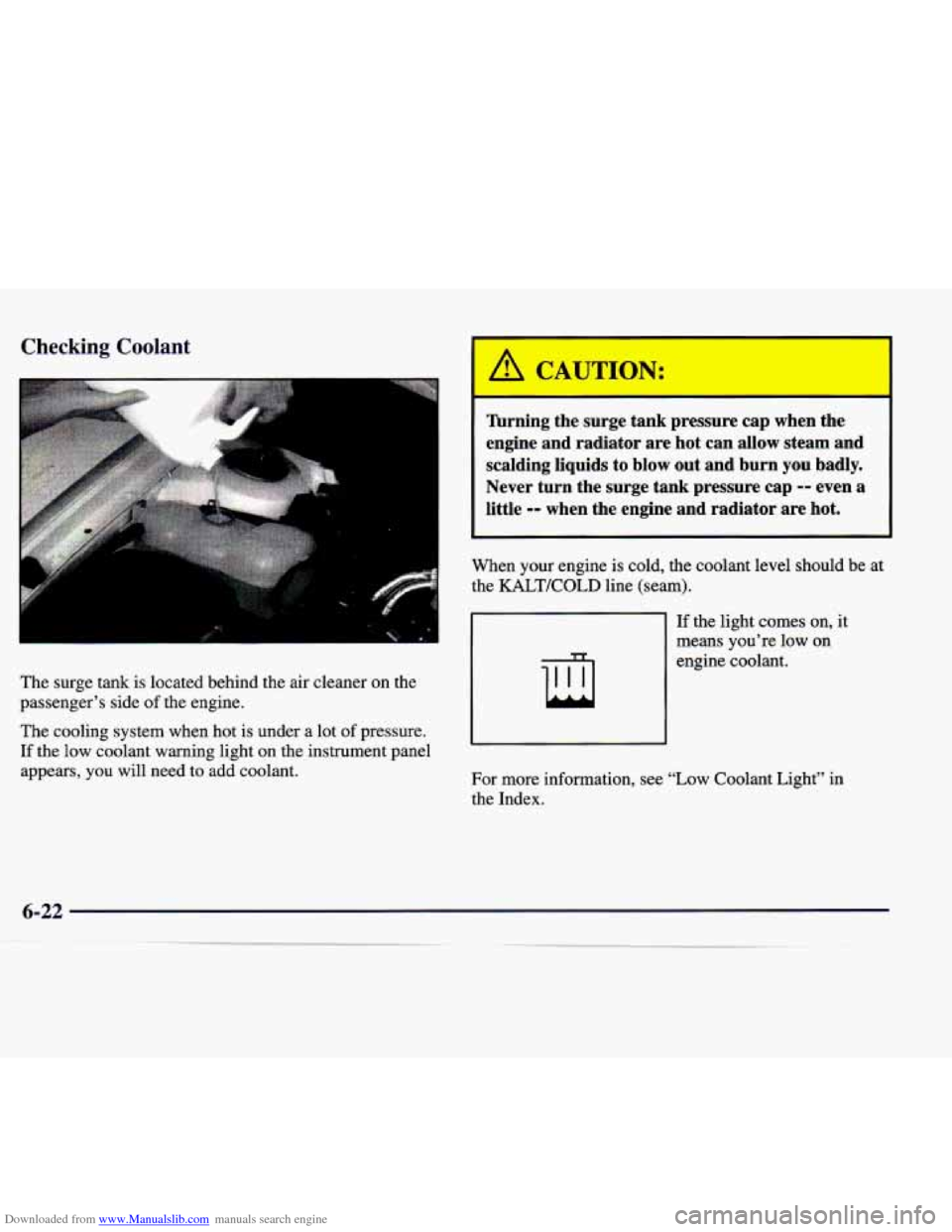
Downloaded from www.Manualslib.com manuals search engine Checking Coolant
The surge tank is located behind the air cleaner on the
passenger’s side
of the engine.
The cooling system when hot is under a lot
of pressure.
If the low coolant warning light on the instrument panel
appears, you will need to add coolant.
= I
Turning the surge tank pressure cap when the
engine and radiator are hot can allow steam and
scalding liquids to blow out and burn you badly.
Never turn the surge tank pressure cap
-- even a
little
-- when the engine and radiator are hot.
When your engine is cold, the coolant level should be at
the KALTKOLD line (seam).
1
If the light comes on, it
means you’re low on
engine coolant.
]I I I
For more information, see “Low Coolant Light” in
the Index.
6-22
.- - ------
Page 272 of 346

Downloaded from www.Manualslib.com manuals search engine Adding Coolant
If you need more coolant, add the proper Dm-COOL@
coolant mixture at the surge tank, but only when the
engine is cool.
You can be burned if you spill coolant on hot
engine parts. Coolant contains ethylene glycol,
Surge Tank Pressure Cap
NOTICE:
The surge tank cap is a 15 psi (105 kPa)
pressure-type cap and must be tightly installed to
prevent coolant loss and possible engine damage
from overheating.
and it will burn if the engine parts are hot
GM cap is recommended. enough. Don’t spill coolant on a hot engine.
If the surge tank pressure cap needs to be replaced, a
Thermostat
When replacing the pressure cap, make sure it is tight.
Engine coolant temperature is controlled by a thermostat
in the engine coolant system. The thermostat stops the
flow of coolant through the radiator until the coolant
reaches a preset temperature.
If the thermostat needs to be replaced, a GM thermostat
is recommended.
Page 273 of 346
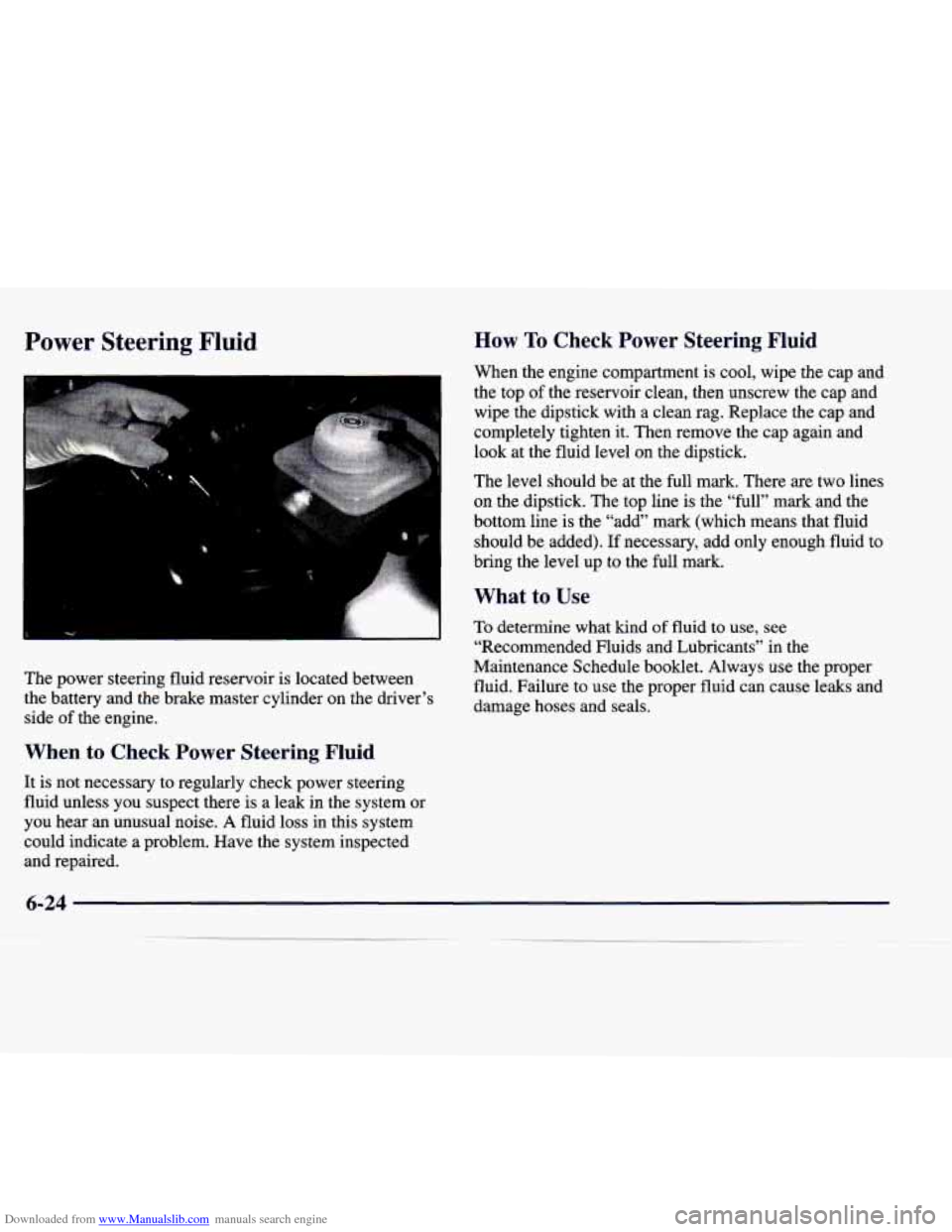
Downloaded from www.Manualslib.com manuals search engine Power Steering Fluid
The power steering fluid reservoir is located between
the battery and the brake master cylinder on the driver’s
side of the engine.
How To Check Power Steering Fluid
When the engine compartment is cool, wipe the cap and
the top
of the reservoir clean, then unscrew the cap and
wipe the dipstick with
a clean rag. Replace the cap and
completely tighten it. Then remove the cap again and
look at the fluid level on the dipstick.
The level should be at the full mark. There are two lines
on the dipstick. The top line is the “full” mark and th\
e
bottom line is the “add” mark (which means that fluid
should be added). If necessary, add only enough fluid to
bring the level up to the full mark.
What to Use
To determine what kind of fluid to use, see
“Recommended Fluids and Lubricants” in the
Maintenance Schedule booklet. Always use the proper
fluid. Failure to use the proper fluid can cause leaks and
damage hoses and seals.
When to Check Power Steering Fluid
It is not necessary to regularly check power steering
fluid unless you suspect there is a leak in the system or
you hear an unusual noise. A fluid loss in this system
could indicate a problem. Have the system inspected
and repaired.
6-24
Page 274 of 346
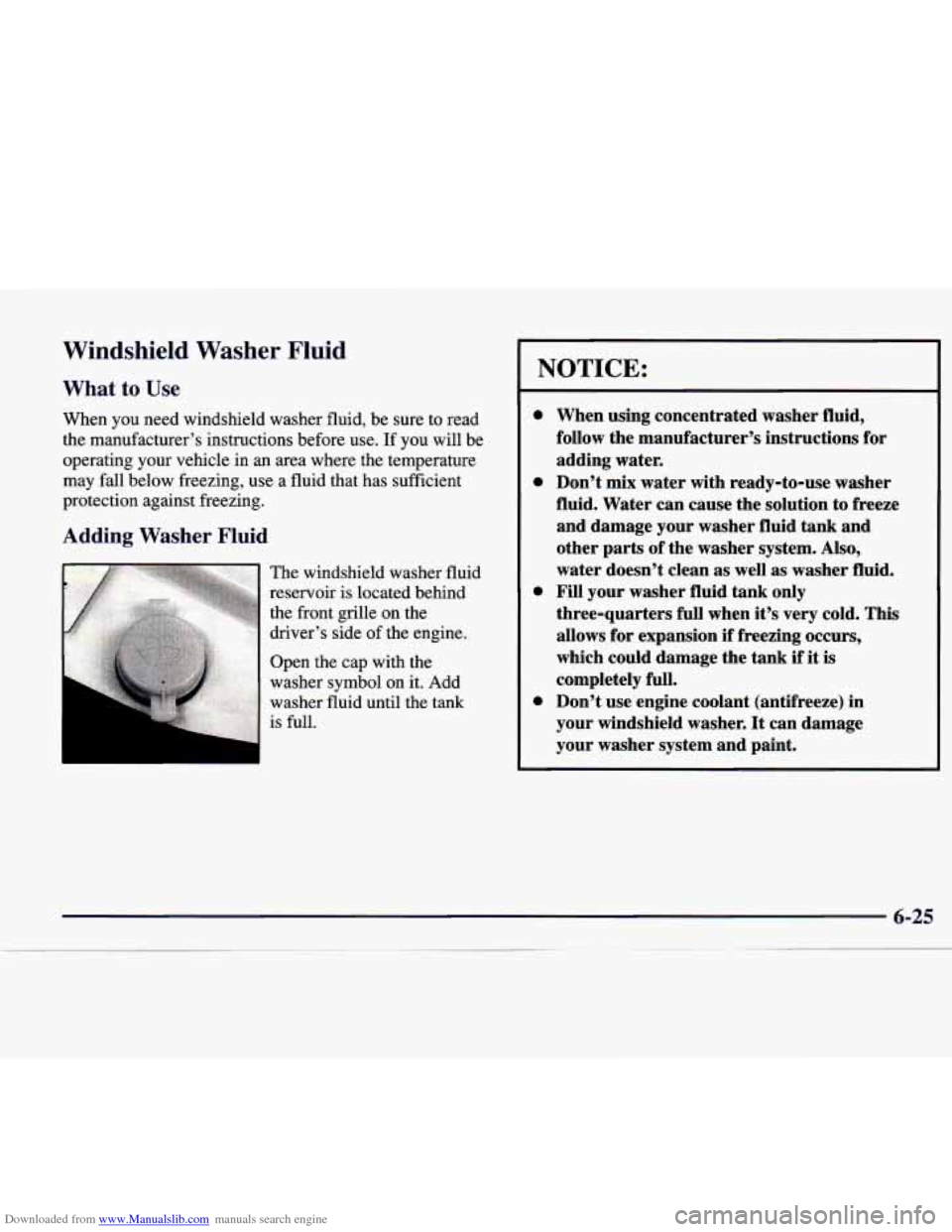
Downloaded from www.Manualslib.com manuals search engine Windshield Washer Fluid
What to Use
When you need windshield washer fluid, be sure to read
the manufacturer’s instructions before use. If you will be
operating your vehicle in
an area where the temperature
may fall below freezing, use a fluid that has sufficient
protection against freezing.
Adding Washer Fluid
The windshield washer fluid
reservoir
is located behind
the front grille on the
driver’s side of the engine.
Open the cap with the
washer symbol on it. Add
washer fluid until the tank
is full.
NOTICE:
e
0
0
e
When using concentrated washer fluid,
follow the manufacturer’s instructions
for
adding water.
Don’t mix water with ready-to-use washer
fluid. Water can cause the solution to freeze
and damage your washer fluid tank and
other parts of the washer system. Also,
water doesn’t clean
as well as washer fluid.
Fill your washer fluid tank only
three-quarters full when
it’s very cold. This
allows for expansion if freezing occurs,
which could damage the tank if
it is
completely full.
Don’t use engine coolant (antifreeze) in
your windshield washer.
It can damage
your washer system and paint.
Page 275 of 346
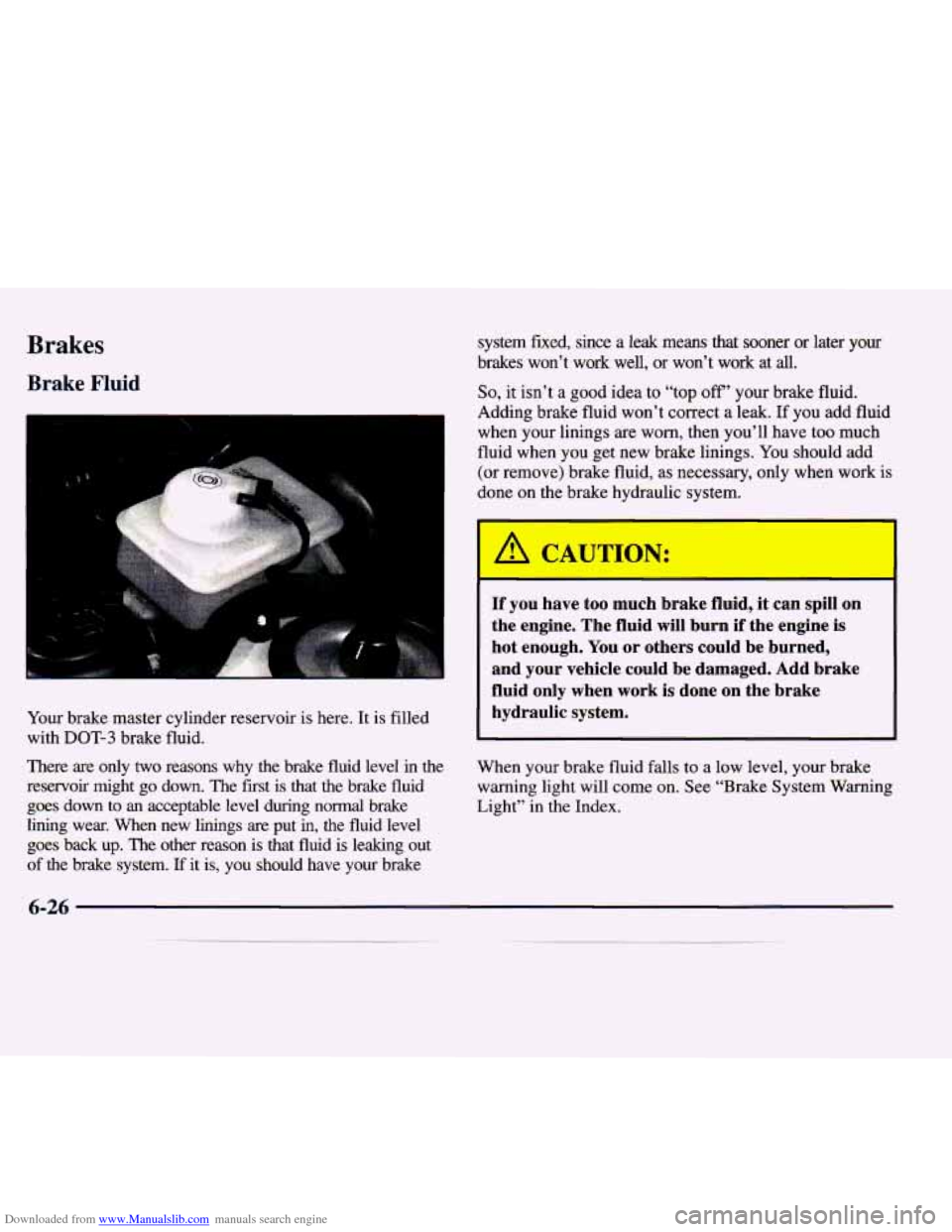
Downloaded from www.Manualslib.com manuals search engine Brakes
Brake Fluid
s
i“
Your brake master cylinder reservoir is here. It is filled
with
DOT-3 brake fluid.
There
are only two reasons why the brake fluid level in the
reservoir might go down. The first
is that the brake fluid
goes down to an acceptable level during normal brake
lining wear. When new linings are put in, the fluid level
goes back up. The other reason is that fluid is leaking out
of the brake system. If it is, you should have your brake system fured, since a leak means that sooner
or later your
brakes won’t work well, or won’t work
at all.
So, it isn’t a good idea to “top off’ your brake fluid.
Adding brake fluid won’t correct
a leak. If you add fluid
when your linings
are worn, then you’ll have too much
fluid when you get new brake linings. You should add
(or remove) brake fluid, as necessary,
only when work is
done on the brake hydraulic system.
A CAV-ION:
If you have too much brake fluid, it can spill on
the engine. The fluid will burn if the engine
is
hot enough. You or others could be burned,
and your vehicle could be damaged. Add brake
fluid only when work is done on the brake
hydraulic system.
When your brake fluid falls to a low level, your brake
warning light will come on. See “Brake System Warning
Light” in the
Index.
Page 276 of 346

Downloaded from www.Manualslib.com manuals search engine What to Add
When you do need brake fluid, use only DOT-3 brake
fluid
-- such as Delco Supreme 11 @ (GM Part
No. 12377967). Use new brake fluid from a sealed
container only.
Always clean
the brake fluid reservoir cap and the area
around the cap before removing it. This will help keep
dirt from entering the reservoir.
With the wrong kind of fluid in your brake
system, your brakes may not work well, or they
may not even work at all. This could cause a
crash. Always use the proper brake fluid.
1
NOTICE:
Using the wrong fluid can badly damage
brake system parts. For example, just a few
drops
of mineral-based oil, such as engine
oil, in your brake system can damage brake
system parts
so badly that they’ll have to be
replaced. Don’t let someone put in the
wrong kind
of fluid.
If you spill brake fluid on your vehicle’s
painted surfaces, the paint finish can be
damaged. Be careful not to spill brake fluid
on your vehicle.
If you do, wash it off
immediately. See “Appearance Care” in
the Index.
Page 277 of 346

Downloaded from www.Manualslib.com manuals search engine Brake Wear
Your vehicle has four-wheel disc brakes.
Your vehicle has electronic wear sensors that let you
know when the front brake pads are significantly worn
and new pads are needed. The brake pad wear indicator
light
will come on and stay on when the brake pads are
worn and need to be replaced. (See “Brake Pad Wear
Indicator Light” in the Index.)
I A CAUTION: I
The brake pad wear indicator light means that
soon your brakes won’t work well. That could
lead to an accident. When the brake pad wear
indicator light comes on and stays on, have your
vehicle serviced.
NOTICE:
Continuing to drive with worn-out brake pads
could result in costly brake repair.
Some driving conditions or climates may cause a brake
squeal when the brakes are first applied
or lightly
applied. This does not mean something is wrong with
your brakes.
Properly torqued wheel bolts are necessary to help
prevent brake pulsation. When tires are rotated, inspect
brake pads for wear and evenly torque wheel bolts in the
proper sequence to GM specifications.
Brake linings should always be replaced as complete
axle sets.
See “Brake System Inspection” in the Maintenance
Schedule booklet under
Part C “Periodic Maintenance
Inspections.”
6-28
Page 278 of 346
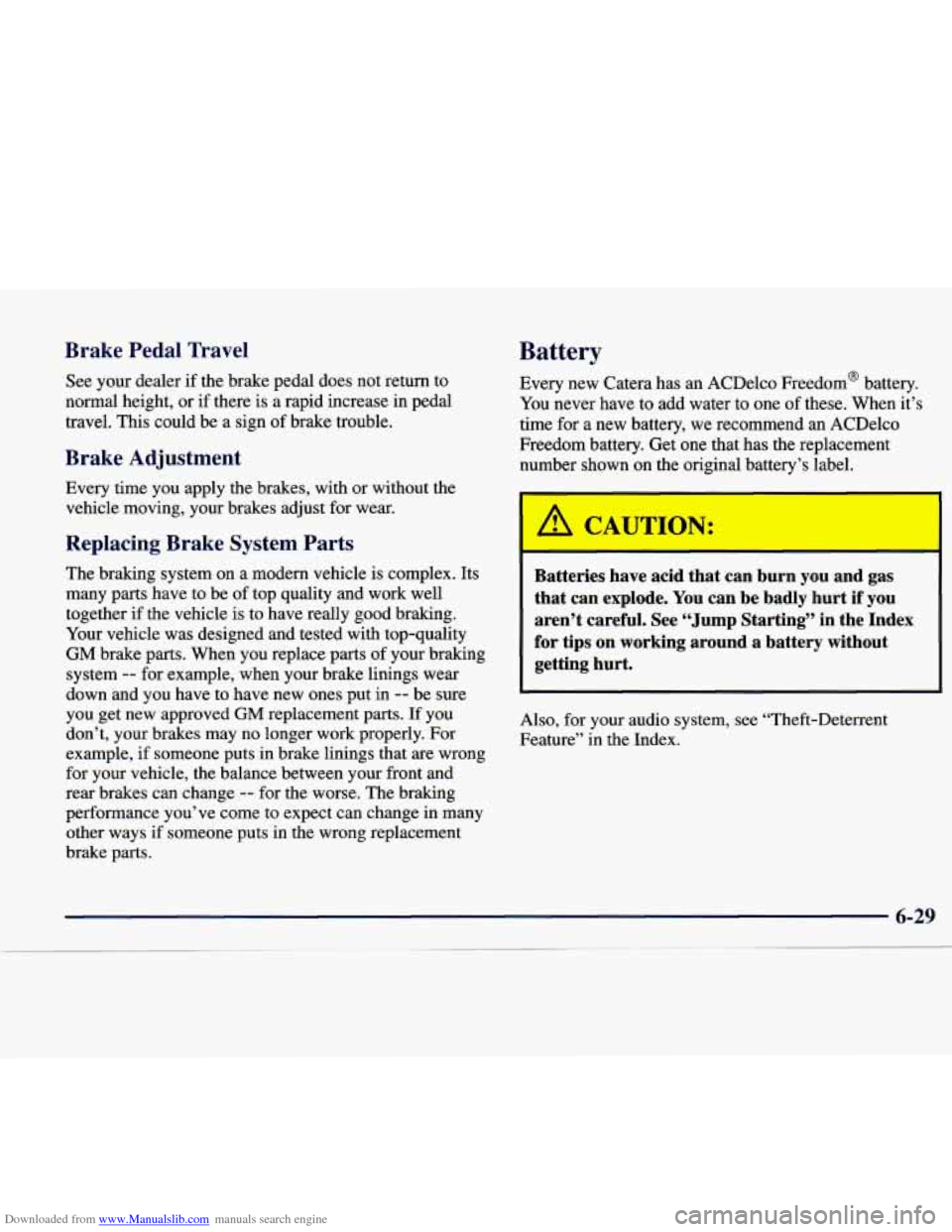
Downloaded from www.Manualslib.com manuals search engine Brake Pedal Travel
See your dealer if the brake pedal does not return to
normal height, or if there is a rapid increase in pedal
travel. This could be a sign
of brake trouble.
Brake Adjustment
Every time you apply the brakes, with or without the
vehicle moving, your brakes adjust for wear.
Replacing Brake System Parts
The braking system on a modern vehicle is complex. Its
many parts have
to be of top quality and work well
together if the vehicle is to have really good braking.
Your vehicle was designed and tested with top-quality
GM brake parts. When you replace parts of
your braking
system
-- for example, when your brake linings wear
down and
you have to have new ones put in -- be sure
you get new approved
GM replacement parts. If you
don’t, your brakes may no longer work properly. For
example, if someone puts in brake linings that are wrong
for your vehicle, the balance between your front and
rear brakes can change
-- for the worse. The braking
performance you’ve come to expect can change in many
other ways if someone puts in the wrong replacement
brake parts.
Battery
Every new Catera has an ACDelco Freedom’ battery.
You never have to add water to one of these. When it’s
time for a new battery, we recommend
an ACDelco
Freedom battery. Get one that has the replacement
number shown on the original battery’s label.
Batteries have acid that can burn you and gas
that can explode. You can be badly hurt if you
aren’t careful. See “Jump Starting’’ in the Index
for tips on working around a battery without getting hurt.
Also, for your audio system, see “Theft-Deterrent
Feature” in the Index.
Page 279 of 346
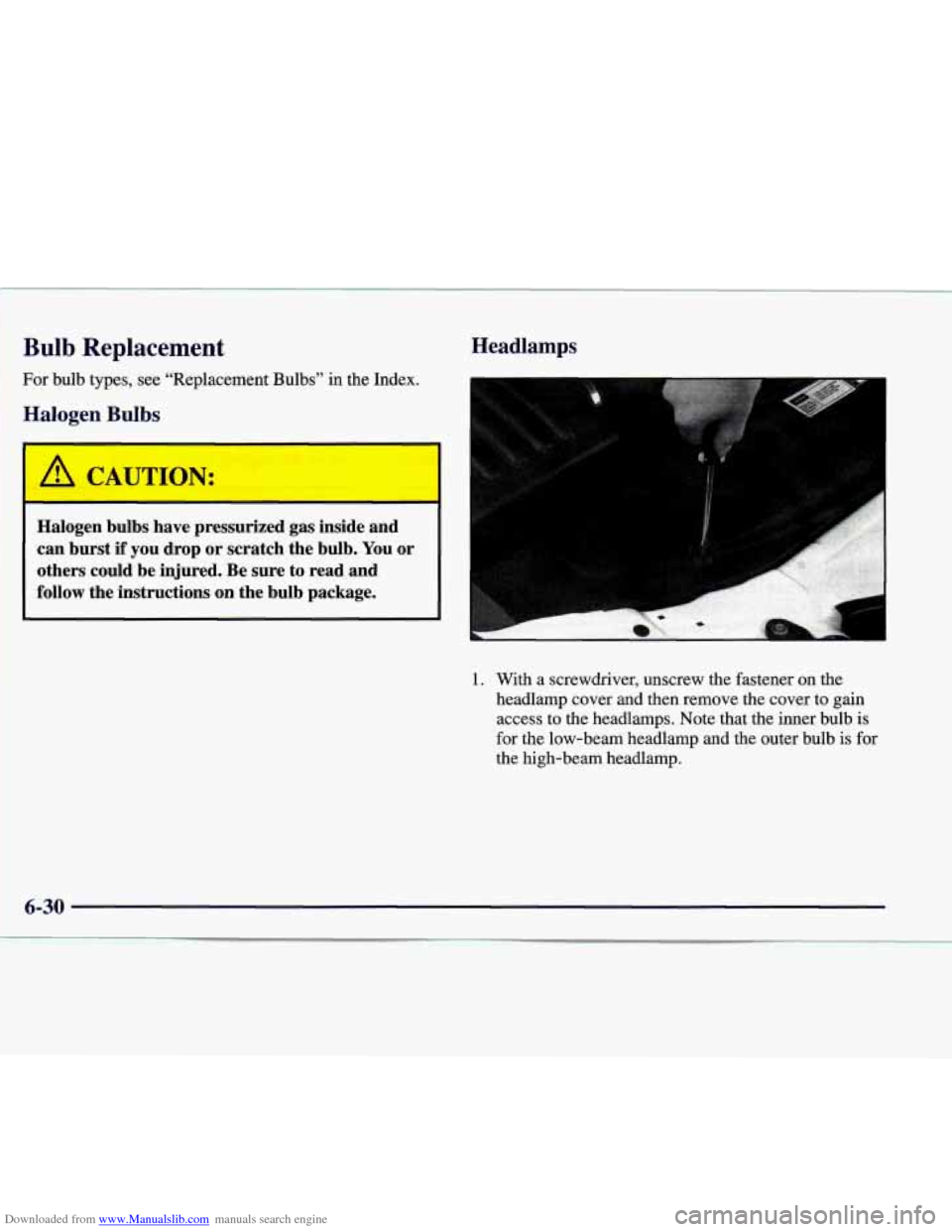
Downloaded from www.Manualslib.com manuals search engine Bulb Replacement
I
~ For bulb types, see “Replacement Bulbs” in the Index.
1 Halogen Bulbs
I I
Halogen bulbs have pressurized gas inside and
can burst
if you drop or scratch the bulb. You or
others could be injured. Be sure to read and
follow the instructions on the bulb package.
Headlamps
1. With a screwdriver, unscrew the fastener on the
headlamp cover and then remove the cover to gain access to the headlamps. Note that the inner bulb
is
for the low-beam headlamp and the outer bulb is for
the high-beam headlamp.
6-30
Page 280 of 346
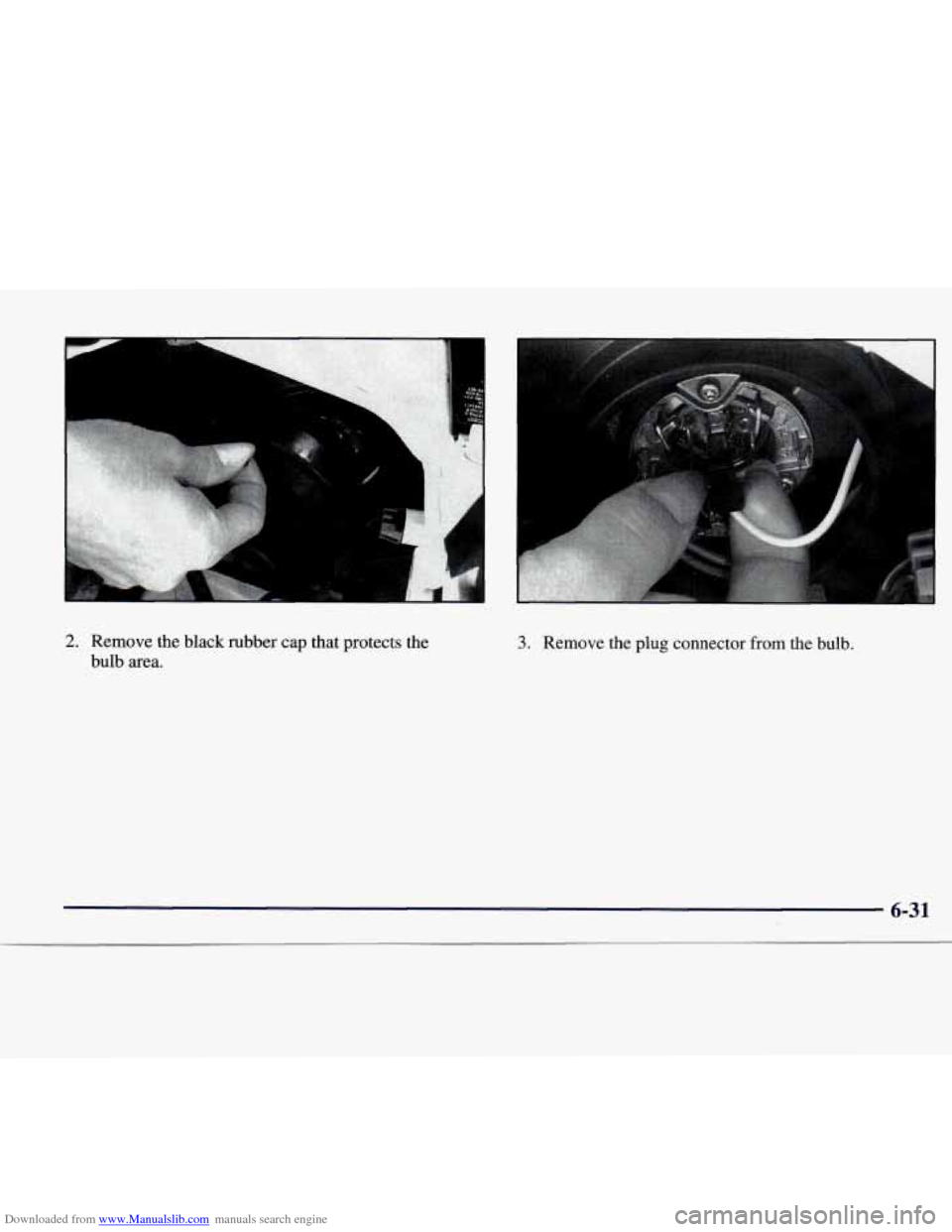
Downloaded from www.Manualslib.com manuals search engine 2. Remove the black rubber cap that protects the
bulb area. 3. Remove the plug connector from the bulb.
6-31